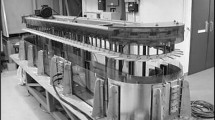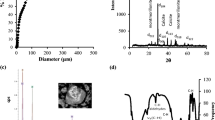Abstract
Experimental models are used to study the poorly known function of pore waters, i.e., their role in hydrosphere pollution. This issue is studied as applied to modern bottom sediments, soil-forming grounds of the aeration zone, and impermeable clays in aquifers. The natural and technogenic geodynamic loads, accompanied by compaction and destruction of water-bearing rocks, are shown to intensify the processes of pore water pressing with the release of rock-forming elements, heavy metals, and organic substances into bottom water layers in water bodies, free soil or intermediate waters. This results in an environmental damage to water bodies, which could be used for drinking water supply and fishery. This study is of particular importance in areas of present-day oil and gas production.
Similar content being viewed by others
References
Abukova, L.A. and Kartsev, A.A., Fluid systems of sedimentary petroleum basins, Otechestvennaya Geol., 1999, no. 2, pp. 11–16.
Apasov, T.K., Abramov, V.O., Mullakaev, M.S., Saltykov, Yu.V., Apasov, G.T., and Apasov, R.T., Complex scheme of ultrasound impact on Samotlor field beds, Nauka i TEK, 2011, no. 6, p. 80.
Blokh, A.M., Struktura vody i geologicheskie protsessy (Water Structure and Geological Processes), Moscow: Nedra, 1969.
Brekhovskikh, V.F., Volkova 3.V., Katunin D.N., Kazmiruk V.D., Ostrovskaya E.V. Heavy metals in bottom sediment in the Upper and Lower Volga, Water Resour., 2002, vol. 29, no. 5, pp. 539–547.
Vaver, V.I., Reclamation of oil-polluted lands, in Biologicheskie resursy i prirodopol’zovanie (Biological Resources and Nature Development), no. 1, Nizhnevartovsk: Nizhnevartovskii ped. inst., 1997.
Vartanyan, G.S., Hydrogeodeformation field of the Earth and some ecogeological problems, Mineral. Resur. Ross., 1994, no. 6, pp. 16–21.
Venitsianov, E.V., Ershova, E.Yu., and Kocharyan, A.G., Heavy metals in bottom sediments of surface waters, Probl. Okruzh. Sredy Prirod. Res., 1994, no. 4, pp. 19–47.
Vernadskii, V.I., Istoriya prirodnykh vod. Izbr. Soch., (History of Natural Waters. Selected Papers), Vol. 4, Book 2, Moscow: AN SSSR, 1960.
Ganeeva, M.V. and Tsel’movich, O.L., On heavy metal distribution in bottom sediments of the Kuibyshev and Rybinsk reservoirs, Vodn. Resur., 1989, no. 1, pp. 170–172.
Davidenko, N.M., Problemy ekologii neftegazonosnykh i gornodobyvayushchikh regionov Severa Rossii (Problems of ecology of petroleum and mining regions in Northern Russia), Novosibirsk: Nauka, 1998.
Denisov, N.Ya., Priroda prochnosti i deformatsii gruntov (Nature of Soil Strength and Deformation), Moscow: Stroiizdat, 1972.
Zverev, V.P., Sistema prirodnykh vod Zemli (System of Natural Waters of the Earth), Moscow: Nauch. mir, 2013.
Kartsev, A.A. and Blokh, A.M., Role of micropore solutions in mass transport processes in lithosphere, in Geologiya i geokhimiya goryuchikh iskopaemykh (Geology and Geochemistry of Mineral Fuels), Kiev: Nauk. dumka, 1980, no. 55, pp. 30–36.
Kleshchev, K.A., Petrov, A.I., and Shein, V.S., Geodinamika i novye tipy prirodnykh rezervuarov nefti i gaza (Geodynamics and New Types of Natural Oil and Gas Reservoirs), Moscow: Nedra, 1995.
Kondrat, V.F., Vibroelectric effect in porous media and its use in GIS, in Netraditsionnye metody geofizicheskikh issledovanii neodnorodnostei v Zemnoi kore (Nonconventional Methods of Geophysical Studies of Heterogeneities in the Earth’s Crust), Moscow: Tr. IFZ RAN, 1993, pp. 46–47.
Kopylov, I.S., Geoenvironmental studies of petroleum regions, Cand. Sci. (Geol.-Miner.) Dissertation, Perm: Perm. Gos. Univ., 2002.
Kosov, V.I., Ivanov, G.N., and Levinskii, V.V., Studying heavy-metal pollution of Upper Volga bottom sediments: Rational Nature Development and Ecology, Vestn. TGTU, 2002, vol. 1, no. 1, pp. 5–9.
Kryukov, P.A., Gornye, pochvennye i ilovye rastvory (Mountain, Soil, and Silt Solutions), Novosibirsk: Nauka, 1971.
Kul’chitskii, L.I., Rol’ vody v formirovanii svoistv glinistykh porod (Role of Water in the Formation of Clay Rock Properties), Moscow: Nedra, 1975.
Luk’yanchikov, V.M., Technogenic pollution of subsoil water by oil products, Extended Abstract of Cand. Sci. (Geol.-Miner.) Dissertation, Moscow: VSEGINGEO, 1986.
Mayuga, M.N., Geology and development of California’s Giant-Wilmington Oil Field, in Geology of Giant Petroleum Fields, Tulsa: American Association of Petroleum Geologists, Memoir 14.
Matusevich, V.M. and Kovyatkina, L.A., Technogenic field and its interaction with physical fields of the Earth, Fundam. Issled., 2013, no. 6, part 2, pp. 402–406.
Matusevich, V.M., Ryl’kov, A.V., and Ushatinskii, I.N., Geoflyuidal’nye sistemy i problemy neftegazonosnosti Zapadno-Sibirskogo megabasseina (Geofluid Systems and Oil and Gas Problems of West Siberian Megabasin), Tyumen’: TyumGNGU, 2005.
Nemirovskaya, I.A., Uglevodorody v okeane (Hydrocarbons in the Ocean), Moscow: Nauch. mir, 2004.
Nikolaev, A.V., Effect of seismic impacts on oil fields and groundwater deposits, in Seismicheskoe vibrovozdeistvie na neftyanuyu zalezh’ (Seismic Impact on Oil Fields), Moscow: IFZ RAN, 1993, pp. 7–13.
Ovcharenko, F.D., Gidrofil’nost’ glin i glinistykh mineralov (The Hydrophilicity of Clays and Clay Minerals), Kiev: Izd. AN USSR, 1961.
Orlov, V.S., Maksimova, V.P., and Pavlov, V.I., Studying physical fields of pipelines at underwater crossings for the development of nature protection measures, in Ekologiya neftegazovogo kompleksa (Ecology of Petroleum Complex), Moscow, 1989, part 2, pp. 44–52.
Osika, D.G. and Cherkashin, V.I., On the fundamental and applied aspects of fluid regime studies in seismically active areas and their margins, in Fundamental’nye problemy neftegazovoi gidrogeologii (Basic Problems of Petroleum Geohydrology), Moscow: GEOS, 2005, pp. 146–149.
Osipov, V.I. and Sokolov, V.N., Gliny i ikh svoistva. Sostav, stroenie i formirovanie svoistv (Clays and Their Properties: Composition, Structure, and the Formation of Properties), Moscow: GEOS, 2013.
Simonenko, V.F., Key mechanism of primary migration and concentration of dispersed hydrocarbonds, in Pervichnaya migratsiya i neftegazonosnost' osadochnykh basseinov (Primary Migration and Oil and Gas Occurrence in Sedimentary Basins), Moscow: VNIGNI, 1988.
Simonenko, V.F., Abukova, L.A., Lashkevich, V.S., and Zhilnina, T.I., Microelements of pore waters as a possible indicator of productivity and environmental conditions in shelf petroleum territories, in Novye idei v geologii i geokhimii nefti i gaza (New Ideas in the Geology and Geochemistry of Oil and Gas), Moscow: GEOS, 2002, book 2, pp. 171–175.
Stukalov, P.M., Aleksakhin, A.I., Ivanov, I.A., and Simkina, N.A., Determining desorption parameters for radionuclides from technogenic silts of V-9 pool (Karachai), Vopr. Radiats. Bezop., 2007, no. 1, pp. 3–16.
Surguchev, M.L., Kuznetsov, O.L., and Simkin, E.M., Gidrodinamicheskoe, akusticheskoe, teplovoe tsiklicheskoe vozdeistvie na neftyanye plasty (Hydrodynamic, Acoustic, and Thermal Cyclic Impact on Petroleum Reservoirs), Moscow: Nedra, 1975.
Tarasevich, Yu.I., The state of bound water in mineral dispersions, Khim. Tekhnol. Vody, 1980, vol. 2, no. 4, pp. 90–107.
Fokin, D.P., Frumin, G.T., and Rybalko, A.E., The concentration and distribution of chemical elements in bottom sediments of the eastern Gulf of Finland, in Ekol. Khim., St. Petersburg, 2010, vol. 19, no. 4, pp. 236–242.
Chizhov, B.E., Vaver, V.I., Dolinger, V.A., Krupinin, N.Ya., and Paunichev, E.A., Lektsii po rekul’tivatsii neftezagryaznennykh zemel’ v KhantyMansiiskom avtonomnom okruge (Lectures on Recultivation of Oil-Polluted Lands in Khanty-Mansi Autonomous District, Tyumen’: Tyumenskii Gos. Univ., 2000.
Shashulovskaya, E.A., The role of shallows in the selfpurification of lowland reservoirs: case study of the Volgograd Reservoir, Cand. Sci. (Biol.) Dissertation, Nizhnii Novgorod: Nizhegor. gos. univ., 2010.
Yusupova, I.F., Abukova, L.A., and Abramova, O.P., Loss of concentrated organic matter by rocks during catagenesis: a factor of geodynamic destabilization, Dokl. Akad. Nauk, 2007, vol. 414, no. 4, pp. 507–510.
Yanturin, A.Sh., Rakhimkulov, R.Sh., and Kagarmanov, N.F., Choice of frequencies for vibration impact on the bottom-hole formation zone, Neft. Khoz., 1986, no. 12, pp. 40–42.
Yakhiyaev, M.A., Salikhov, Sh.K., Shaikhalova, Zh.O., and Salmanov, A.B., Microelement concentrations and pollution level of bottom sediments on the Western Caspian coast, Yug Rossii: Ekol., Razv., 2007, no. 2, pp. 95–98.
Abdul, S.A., A new pumping strategy for petroleum product recovery from contaminated hydrogeologic systems: laboratory and field evaluations, Groundwater Monit. Rem., 1992, vol. 12, Iss. 1, pp. 105–114.
Abramova, O., Abukova, L., and Isaeva, G., Pore water—indicator of geological environment condition, Advances in the Research of Aquatic Environment, 2011, vol. 2, pp. 145–150.
Ansari, A.A., Singh, I.B., and Tobschall, H.J., Role of monsoon rain on concentrations and dispersion patterns of metal pollutants in sediments and soils of the Ganga Plain, India, Environ. Geol., 2000, vol. 39, no. 3, 4, pp. 221–237.
Baram, S., Kurtzman, D., and Dahan, O., Water percolation through a clayey vadose zone, J. Hydrol., 2012, vol. 424–425, pp. 165–171.
Johnson, P.C., Kemblowski, M.W., and Colthart, J.D., Quantitative analysis for the cleanup of hydrocarbon contaminated soils by in-situ soil venting, J. Ground Water, 1990, vol. 28, no. 3, pp. 413–429.
Kia, S.F. and Abdul, A.S., Retention of diesel fuel in aquifer material, J. Hydraul. Engin., 1990, vol. 116, no. 7, pp. 881–894.
Mukherjee, D., Mukherjee, A., B. Kumar, Chemical fractionation of metals in freshly deposited marine estuarine sediments of Sundarban ecosystem, India, Environ. Geol., October 2009, vol. 58, no. 8, pp. 1757–1767.
Norton, S.A., Henriksen, A., Appleby, P.G., Vereault, D.V., and Traaen, T.S., Trace Metal Pollution in Eastern Finnmark, Norway, as Evidenced by Studies of Lake Sediments, Oslo: SFT-report cores, 1992.
Singh, M. and Muller, G., Heavy metals in freshly deposited stream sediments of rivers, associated with urbanization of the Ganga plain, India, Water, Air, Soil Pollut., 2002, vol. 141, nos. 1–4, pp. 35–54.
Tödheide, K., Hydrothermal solutions. Berichte der Bunsengesellschaft für physikalische Chemie, 1982, vol. 86, no. 11, pp. 1005–1016.
Author information
Authors and Affiliations
Corresponding author
Additional information
Original Russian Text © L.A. Abukova, O.P. Abramova, 2016, published in Vodnye Resursy, 2016, Vol. 43, No. 4, pp. 431–441.
Rights and permissions
About this article
Cite this article
Abukova, L.A., Abramova, O.P. Effect of pore water of fine sediments on the ecological conditions of hydrosphere under oil-and-gas technogenesis conditions. Water Resour 43, 668–676 (2016). https://doi.org/10.1134/S0097807816040023
Received:
Published:
Issue Date:
DOI: https://doi.org/10.1134/S0097807816040023




